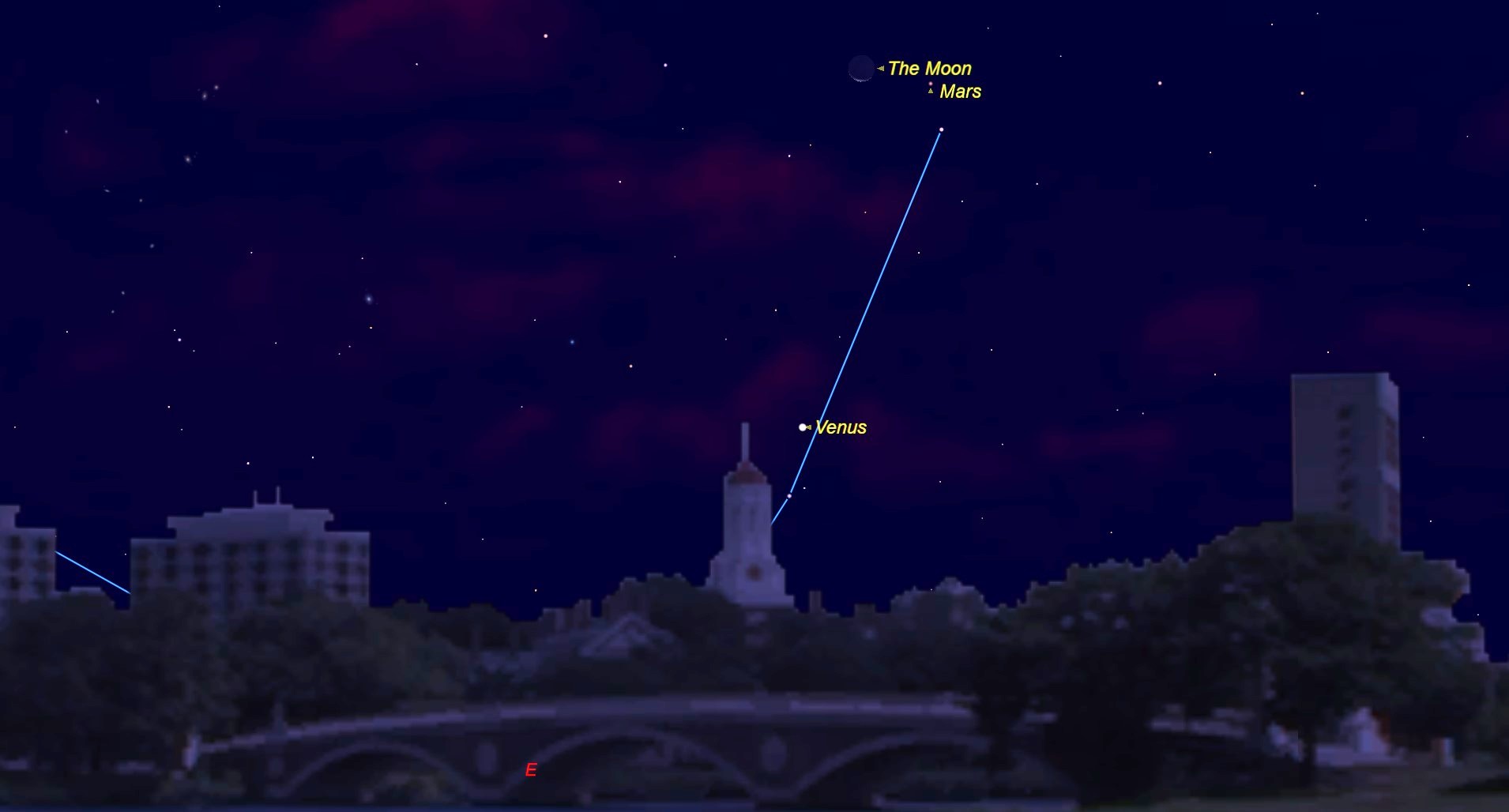See the Moon, Venus and Mars Together Before Dawn Tuesday!

A gathering of two bright planets and the slender crescent moon will be the chief celestial attraction in the predawn sky Tuesday (Oct. 17).
If you look low toward the eastern horizon about 60 to 75 minutes before sunrise (make sure there aren't any trees or buildings to obstruct your view), you should readily catch sight of the very narrow (6-percent illuminated) crescent moon, weather permitting. And situated only 1.3-degrees to the left you see yellow-orange Mars, while 8-degrees below will blaze Venus.
If you've been up before sunrise these past couple of weeks, you may have noticed how Venus and Mars have been changing positions with each other on successive mornings. In fact, on Oct. 5, they appeared very close to each other, separated by just a quarter of a degree. Since that time, they have been slowly drawing apart; Venus getting lower a bit lower each morning and Mars getting a bit higher. [The Brightest Planets in October's Night Sky]
And on Tuesday morning, the moon will join them, forming a rather broad triangle low in the eastern sky just prior to sunrise.
So far as the planets are concerned, Oct 5 was literally the celestial equivalent of two ships passing in the night. Mars continues to move ahead of Earth in its orbit around the sun, and rises around 5 a.m. (your local time) all month. Still on the far side of the sun, this 2nd-magnitude planet appears a tiny disk even in moderately large telescopes. But Earth is slowly gaining on the Red Planet, with Mars appearing higher in the eastern sky each day. Venus on the other hand, rises just before the first gleam of morning twilight throughout most of October and sinks closer to the eastern horizon as it retreats to the far side of the sun.
And Tuesday morning, both planets and the moon will form a widely spaced, albeit eye-catching gathering for early risers on route to work and school. Most will likely just give the trio a cursory glance, but to ancient skywatchers such a gather may have had made a far greater impression.
What does it mean?
Ancient humans probably took note of the fact that the planets — themselves resembling bright stars — had the freedom to wander in the heavens, while the other "fixed" stars remained rooted in their positions. This ability to move, seemed to have an almost magical, god-like quality. And evidence that the planets came to be associated with the gods, lies in their very names, which represent ancient deities.
Breaking space news, the latest updates on rocket launches, skywatching events and more!
Thousands of years ago, skywatchers must have deduced that if the movements of the planets had any significance at all, it must be to inform those who could read celestial signs of what the fates held in store. Indeed, even to this day, many newspapers carry horoscopes, catering to those who firmly believe that the changing positions of the sun, moon and planets can have a decided effect on the destinies of individuals and nations on the Earth.
But as for any chance that the impending moon/planet gathering might have any influence on our lives in any way, forget it. No astrologer can predict from planetary alignments or any other celestial configuration when a specific event, good or bad, will occur on Earth.
In any case, it will still be worth a look.
Editor's note: If you have an amazing night-sky photo you'd like to share with us and our news partners for a possible story or image gallery, send images and comments in to spacephotos@space.com.
Joe Rao serves as an instructor and guest lecturer at New York's Hayden Planetarium. He writes about astronomy for Natural History magazine, the Farmers' Almanac and other publications, and he is also an on-camera meteorologist for Fios1 News in Rye Brook, NY. Follow us @Spacedotcom, Facebook or Google+. Originally published on Space.com.

Joe Rao is Space.com's skywatching columnist, as well as a veteran meteorologist and eclipse chaser who also serves as an instructor and guest lecturer at New York's Hayden Planetarium. He writes about astronomy for Natural History magazine, Sky & Telescope and other publications. Joe is an 8-time Emmy-nominated meteorologist who served the Putnam Valley region of New York for over 21 years. You can find him on Twitter and YouTube tracking lunar and solar eclipses, meteor showers and more. To find out Joe's latest project, visit him on Twitter.
